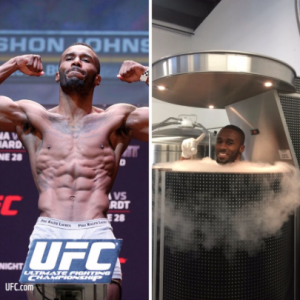
Photo c.o. www.sandiegocryotherapy.com
For the trainee, whether athlete or non-athlete, recovery needs to be a serious consideration. Everyone talks about ‘overtraining’ but it could quite easily be said that there is only ‘under recovery’. Management of training load along with recovery and regeneration strategies ensures that ‘overtraining’ doesn’t even come into the equation.
Recovery is the process of physically or psychologically overcoming the stresses caused by training.
Rest – Time off with no training at all.
Active Rest – Non-training days, supplemented by non-related physical activity.
Strategies for optimal sleep, pre and post-workout nutrition as well as recovery days, download weeks etc., should be implemented. An attempt to include regeneration days into any training regimen should definitely be made, an adequate regeneration strategy could well be the difference between winning and losing.
Post-Fight Recovery
For the combat athlete, a post-competition strategy is just as important as what is done pre-competition, reducing both recovery time and aches & pains.
- Post event shake and meal/snack
- Carbohydrate and protein to both replace glycogen stores and rebuild muscle
- Hot and cold therapy, even if it’s hot and cold showers in order to promote recovery. Finishing with cold is best
- Drinking lots of water and replenishing electrolytes is of the utmost importance
- For several days post competition active rest should be used, including flexibility and soft tissue work
Sleep
Sleep is without a doubt the No.1 performance enhancer and the athlete suffering from a lack of sleep is only a shadow of their potential self.
The ideal time to sleep for optimal performance is between 22:00 and 06:00 the following morning and while this may not always be possible, aiming for those times will go a long way in achieving both peak health and performance.
Lights should be dimmed and phones and computers should not be used in the run-up to going to bed.
The body’s circadian rhythm (biological clock) is altered by the blue light given off by electronic devices and energy efficient lightbulbs. Whilst blue light can be beneficial during daylight hours by boosting attention and reaction times it does have a negative effect on sleep patterns and so health and performance after sundown.
For those that need to be using electronic devices at night, while not ideal, orange/amber lensed glasses have been shown to reduce the effects of blue light.
Strategies
- Dim red night-lights have the least power to shift circadian rhythm
- Attempt to avoid bright screens in the final 2-3 hours before bed
Light causes the release of the stress hormone cortisol. Cortisol levels peak naturally between 06:00 and 09:00 and remain high until around midday and after which they start to decrease. Looking at electronic screens late in the day will elevate cortisol and prevent the normal release of melatonin.
Ideally a bedroom should be pitch black, if this is not possible then the very minimum should be the use of an eye mask.
The ideal temperature of the bedroom in order to achieve no disruption of sleep is 20°C (68°F).
Any electrical items that are located close by and can be unplugged should be, to avoid further sleep disruption due to electromagnetic stress.
Carbs before bed such as porridge or oatmeal raise melatonin and so help promote restful sleep.
Caffeine, nicotine, alcohol and sugar will almost definitely disrupt sleep if consumed within six hours of going to bed.
Soft Tissue Work
Soft tissue work on recovery days can be priceless. Examples such as:
- Active Release Technique (ART)
- Graston Technique
- Sports Massage Therapy
- Fascial Stretch Therapy
- ELDOA
Also for recovery & regeneration:
- Heart Rate Variability
- Perceptual-cognitive Training
- Cryotherapy
- Compression Wear
- Compression Boots
- Floatation Tanks
Boxing, MMA, BJJ, Muay Thai, Strength & Conditioning, Combat Sports, Athlete, Sports Performance, Online Coaching.
